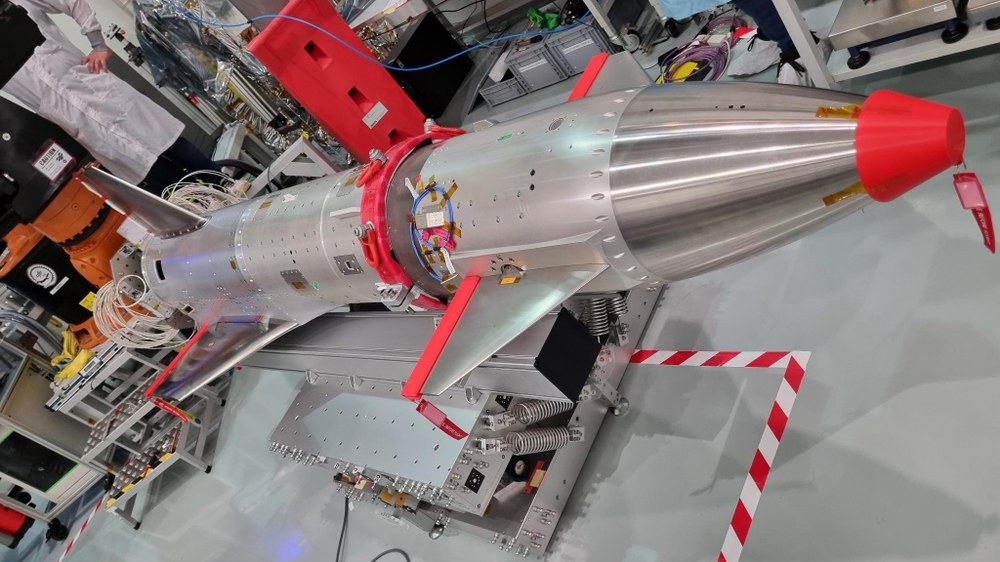Institute of Space Systems
Participation in ReFEx: project management; systems engineering; final assembly; quality control; studies; guidance, navigation and control; avionics; cold gas propulsion; test facilities



DLR is developing the ReFEx (Reusability Flight Experiment) technology demonstrator for a vertical take-off and horizontal landing rocket stage (VTHL). The platform will demonstrate various key technologies, including an aerodynamic design that enables ReFEx to fly stably within the atmosphere over a wide range of speeds; an autonomous guidance, navigation and control (GNC) system designed to maintain an optimal flight path; and status monitoring using the latest sensor technologies. Monitoring systems include specially arranged pressure sensors integrated into the structure to measure speed and attitude, along with fibre-optics used to measure ReFEx’s thermal and mechanical deformation.
ReFEx is 2.7 metres long, with a wingspan of approximately 1.1 metres and a mass of around 375 kilograms. The demonstrator itself has no propulsion technology, apart from a cold gas system used for attitude control in space. ReFEx forms the upper stage of a specially modified two-stage, Brazilian-made VSB-30 sounding rocket. To avoid stability issues during ascent, a fairing is used to initially cover the main folding wings and is discarded before re-entry. The chosen geometry allows for both a stable ascent and a viable, stable and controllable re-entry trajectory.
Following launch, the VSB-30 will carry ReFEx up to an altitude of approximately 130 kilometres – roughly equivalent to the first stage separation in conventional space transport systems. ReFEx will then return to Earth on a trajectory resembling that of a winged first stage.
Outside Earth’s atmosphere, ReFEx will use its cold gas thrusters to perform several manoeuvres and refine its 'navigation solution' after launch. The demonstrator will then align itself for atmospheric re-entry. This is where the aerodynamic control system – including the front wings (known as canards) and a rear rudder – comes into play.

Video: Technology demonstrator ReFEx
Your consent to the storage of data ('cookies') is required for the playback of this video on Youtube.com. You can view and change your current data storage settings at any time under privacy.
Re-entry is fraught with challenging flight conditions, including a wide range of speeds and angles of attack, from hypersonic to subsonic. During re-entry, ReFEx will reach peak speeds of approximately Mach 5 – five times the speed of sound, or roughly 1.5 kilometres per second (5400 kilometres per hour).
For the initial phase of re-entry, the demonstrator is flown upside down, at high negative angles of attack to reduce speed and maintain flight stability. At Mach 1.5, ReFEx will perform a 180-degree roll manoeuvre around its longitudinal axis to align itself with an angle of attack of up to 10 degrees – the maximum ratio of lift to drag.
In addition to flying autonomously on an optimised flight path to reduce thermal and mechanical loads, ReFEx is designed to demonstrate its steering capability by executing a turn of at least 30 degrees – a key capability for a rocket stage returning to its launch site. In the event of anomalies, ReFEx will also be able to automatically select and divert to predefined secondary landing sites immediately after separation from its launch vehicle.
Development and final assembly are currently scheduled for completion in 2026, followed by the final review before shipment to Australia. The launch will take place from the Koonibba Test Range (KTR) in South Australia. The launch site is operated by Southern Launch and the Koonibba Aboriginal Community, who work in partnership to enable suborbital launches – where a rocket returns to Earth without completing an orbit or escaping Earth’s gravitational pull – and return flights from space.
